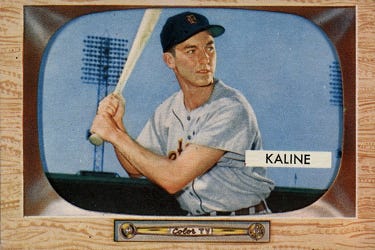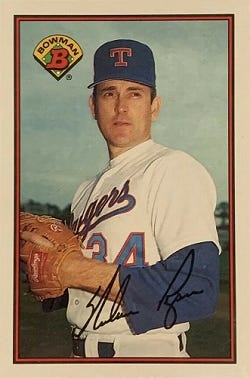Over on YouTube this week, we took a stroll through some (oxymoron alert) top-selling 1989 Bowman baseball cards. You can check that out below:
Whenever I catch a glimpse of 1989 Bowman, I can’t help but remember how exciting it was when the brand came back to the market.
And it also reminded me that, no matter how much we love our cards, some of them are tragic cardboard heroes, suffering from fatal flaws that seal their fate from the start.
Cryptic, huh?
Well, here — have a look at some off-kilter cards that demonstrate what I mean …
1955 Bowman: The Flakes of Fate
The 1955 Bowman set was sort of doomed from the start, probably the moment someone snapped their fingers and said, “Say, how about we make them little TV sets?”
Now, don’t get me wrong — the concept was innovative and fit the times. It was just a stark departure from Bowman’s designs up to that point, and from Topps’ emerging standard.
If it didn’t work, it was going to flop.
Or flake.
I first encountered 1955 Bowman “in person” at a card show in the mid-1980s, where I met my first Al Kaline card and noticed right away that the edges of the TV cabinet were flapping away from the carboard beneath.
I had to have that card anyway (it was a circumstantial thing), but the years since have taught me that Mr. Tiger wasn’t alone in his 1955 Bowman affliction.
The assembly process seemed to be something like:
Print the card backs on cardboard
Print the card fronts on cornflakes
Have some kids lick the
cornflakescard fronts and stick them to the backsPray
Sell to Topps
Kellogg’s: The Crack of Doom
I didn’t start collecting for real until 1983, and by then, at least in our area, there were no baseball cards in cereal boxes (though Cookie Crisp would give us a reprieve the next year).
But I had heard and read stories about the joys of fishing your dirty little paw through a box of cornflakes to find the fancy little cards hiding inside.
I eventually did get my own dirty little paws on a few of those 3D beauties, just not as in quite as exciting fashion.
And, of course, more than a few of my Kellogg’s cards were/are bowed like a violin and cracked like that glass you took out of the dishwasher and filled with iced tea.
1981 Topps Scratch-Offs
The 1981 Topps Scratch-Offs never stood a chance at a normal life. Consider the lot they were born into:
Oversize panels
Undersize individual cards
Perforated borders encouraging kids to tear the cards apart
Scratch-off circles on the card fronts encouraging kids to scraped then with coins, fingernails, pocketknives, and other destructive implements
Add in cardstock that made the base Topps sets feel like slabs of limestone by comparison, and it’s a miracle any of these survive today.
Probably helps that hardly anybody wanted them in the first place.
1986 Sportflics: Plastic Pejorative Picasso
Sportflics were the most exciting thing to happen to the hobby in years, adding a fourth brand to the Topps-Fleer-Donruss triumvirate that had dominated since 1981. They were also bringing innovations: Mylar packs, photos on card backs, Magic Motion triple exposures.
It was all great until we started popping open the super-expensive (65 cents) packs to find out which three cards we had been graced with. And, almost always, it was impossible to tell.
The card backs were awesome.
The card fronts? Indecipherable, thanks the Magic Motion itself, rendering each card a jumbled mess like some misguided attempt at art.
1989 Bowman: Rough Around the Edges
Even as Upper Deck was stirring up the hobby with Sportflics-level promises, Topps was busy wowing us with its own bombshell — they were bringing back the deposed Bowman brand after nearly 35 years!
It was about as awesome an idea you could even imagine, evoking memories and visions of the hobby’s glorious sepia-toned past.
For the most part, 1989 Bowman hit the mark, unveiling big, clear photos with a simple, elegant design. Heck, Topps even bumped up the card height by a quarter inch, giving it a real mid-1950s feel.
And that was its fatal flaw.
It didn’t take us long at all to figure out that it was tough to store these puppies with our “normal” cards. And when we tried to shoehorn them in, the result was almost always banged up edges and corners, and sometimes creases.
Most of us pretty much gave up our Bowman dreams after a pack or two, and Topps capitulated to our whims by shrinking 1990 Bowman to fit the mold. It was almost too late, but a couple years of dedicated rehabilitation left Bowman as THE place to go for rookies.
Today, you can still pick out 1989 Bowman cards in a collection at just a glance.
They’re the raggedy ones, jutting out here and there, all but forgotten.
—
How about you? What fatal flaws have you uncovered in the cards in YOUR collection?
I’d love to hear about them.
Of course, the worst baseball card I’ve ever owned is still better than a day without a card.
So, until next time, enjoy whatever cards you run across, no matter how flawed. Nobody’s perfect, after all.
—Adam








